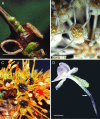Nectar and pollination drops: how different are they?
- PMID: 19477895
- PMCID: PMC2710891
- DOI: 10.1093/aob/mcp124
Nectar and pollination drops: how different are they?
Abstract
Background: Pollination drops and nectars (floral nectars) are secretions related to plant reproduction. The pollination drop is the landing site for the majority of gymnosperm pollen, whereas nectar of angiosperm flowers represents a common nutritional resource for a large variety of pollinators. Extrafloral nectars also are known from all vascular plants, although among the gymnosperms they are restricted to the Gnetales. Extrafloral nectars are not generally involved in reproduction but serve as 'reward' for ants defending plants against herbivores (indirect defence).
Scope: Although very different in their task, nectars and pollination drops share some features, e.g. basic chemical composition and eventual consumption by animals. This has led some authors to call these secretions collectively nectar. Modern techniques that permit chemical analysis and protein characterization have very recently added important information about these sugary secretions that appear to be much more than a 'reward' for pollinating (floral nectar) and defending animals (extrafloral nectar) or a landing site for pollen (pollination drop).
Conclusions: Nectar and pollination drops contain sugars as the main components, but the total concentration and the relative proportions are different. They also contain amino acids, of which proline is frequently the most abundant. Proteomic studies have revealed the presence of common functional classes of proteins such as invertases and defence-related proteins in nectar (floral and extrafloral) and pollination drops. Invertases allow for dynamic rearrangement of sugar composition following secretion. Defence-related proteins provide protection from invasion by fungi and bacteria. Currently, only few species have been studied in any depth. The chemical composition of the pollination drop must be investigated in a larger number of species if eventual phylogenetic relationships are to be revealed. Much more information can be provided from further proteomic studies of both nectar and pollination drop that will contribute to the study of plant reproduction and evolution.
Figures


Similar articles
-
The Evolution of Sexual Fluids in Gymnosperms From Pollination Drops to Nectar.Front Plant Sci. 2018 Dec 18;9:1844. doi: 10.3389/fpls.2018.01844. eCollection 2018. Front Plant Sci. 2018. PMID: 30619413 Free PMC article. Review.
-
Patterns of floral nectar standing crops allow plants to manipulate their pollinators.Sci Rep. 2020 Feb 3;10(1):1660. doi: 10.1038/s41598-020-58102-7. Sci Rep. 2020. PMID: 32015366 Free PMC article.
-
Phylogenetic and functional signals in gymnosperm ovular secretions.Ann Bot. 2017 Nov 28;120(6):923-936. doi: 10.1093/aob/mcx103. Ann Bot. 2017. PMID: 29045531 Free PMC article.
-
Complex reproductive secretions occur in all extant gymnosperm lineages: a proteomic survey of gymnosperm pollination drops.Plant Reprod. 2019 Jun;32(2):153-166. doi: 10.1007/s00497-018-0348-z. Epub 2018 Nov 14. Plant Reprod. 2019. PMID: 30430247 Free PMC article.
-
Nectar chemistry is tailored for both attraction of mutualists and protection from exploiters.Plant Signal Behav. 2009 Sep;4(9):809-13. doi: 10.4161/psb.4.9.9393. Epub 2009 Sep 24. Plant Signal Behav. 2009. PMID: 19847105 Free PMC article. Review.
Cited by
-
Application of proteomics to the study of pollination drops.Appl Plant Sci. 2013 Apr 5;1(4):apps.1300008. doi: 10.3732/apps.1300008. eCollection 2013 Apr. Appl Plant Sci. 2013. PMID: 25202539 Free PMC article.
-
The Evolution of Sexual Fluids in Gymnosperms From Pollination Drops to Nectar.Front Plant Sci. 2018 Dec 18;9:1844. doi: 10.3389/fpls.2018.01844. eCollection 2018. Front Plant Sci. 2018. PMID: 30619413 Free PMC article. Review.
-
Nectar in Plant-Insect Mutualistic Relationships: From Food Reward to Partner Manipulation.Front Plant Sci. 2018 Jul 19;9:1063. doi: 10.3389/fpls.2018.01063. eCollection 2018. Front Plant Sci. 2018. PMID: 30073014 Free PMC article. Review.
-
Water status and associated processes mark critical stages in pollen development and functioning.Ann Bot. 2012 Jun;109(7):1201-14. doi: 10.1093/aob/mcs070. Epub 2012 Apr 19. Ann Bot. 2012. PMID: 22523424 Free PMC article. Review.
-
The effects of dietary proline, β-alanine, and γ-aminobutyric acid (GABA) on the nest construction behavior in the Oriental hornet (Vespa orientalis).Sci Rep. 2022 May 6;12(1):7449. doi: 10.1038/s41598-022-11579-w. Sci Rep. 2022. PMID: 35523992 Free PMC article.
References
-
- Akazawa T, Okamoto K. Biosynthesis and metabolism of sucrose. In: Stumpf PK, Conn EE, editors. The biochemistry of plants, a comprehensive treatise. New York, NY: Academic Press; 1980. pp. 199–220.
-
- Alm J, Ohnmeiss TE, Lanza J, Vriesenga L. Preference of cabbage white butterflies and honey bees for nectar that contains amino acids. Oecologia. 1990;84:53–57. - PubMed
-
- Baker HG, Baker I. A brief historical review of the chemistry of floral nectar. In: Bentley B, Elias T, editors. The biology of nectaries. New York, NY: Columbia University Press; 1983a. pp. 126–151.
-
- Baker HG, Baker I. Floral nectar sugar constituents in relation to pollinator type. In: Little RJ, Jones CE, editors. Handbook of pollination biology. New York, NY: Scientific and Academic Editions; 1983b. pp. 117–141.
-
- Baker HG, Baker I. The occurrence and significance of amino acids in floral nectar. Plant Systematics and Evolution. 1986;151:175–186.
Publication types
MeSH terms
LinkOut - more resources
Full Text Sources
Miscellaneous

